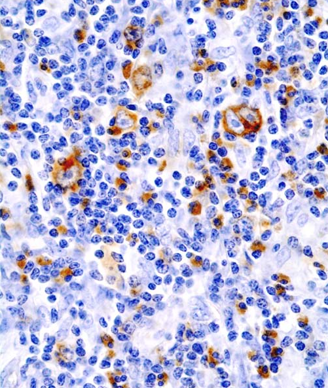AETHERA: Brentuximab Vedotin Delays HL Progression Post-ASCT
Early consolidation therapy with brentuximab vedotin after autologous stem cell transplant improved progression-free survival of patients with Hodgkin lymphoma.
Histopathologic image of Hodgkin lymphoma, CD30 immunostain; source: KGH, Wikimedia Commons

SAN FRANCISCO-Early consolidation therapy with brentuximab vedotin after autologous stem cell transplant improved the progression-free survival of patients with Hodgkin lymphoma and risk factors for relapse or progression, according to the results of the AETHERA trial presented by Craig Moskowitz, MD, of Memorial Sloan Kettering Cancer Center.
“Once this is published, in this particular patient population … I do believe that it will become standard treatment,” Moskowitz during his oral abstract presentation.
The trial included 329 patients at risk for post-transplant disease progression. All patients in the trial were enrolled into a high risk category, either refractory to frontline therapy, relapse less than 12 months after frontline therapy, or relapse 12 months or longer after frontline therapy with extranodal disease. Prior to transplant, all patients had to have achieved remission or have stable, non-progressing disease.
The patients were randomly assigned to best supportive care plus 16 cycles of brentuximab vedotin 1.8 mg/kg every 3 weeks or placebo for up to 1 year. Around 45% of patients in each arm had received two or more prior systemic salvage therapies. Patients who progressed on placebo were allowed to subsequently receive the study drug on an another trial. The primary endpoint of progression-free survival was assessed by an independent review facility.
Median follow-up was 24.4 months. At 2 years, the researchers observed significantly improved progression-free survival among patients assigned the study drug looking at either independent review (63% vs 51%; HR = 0.57; 95% CI, 0.40-0.81) or per investigator review (65% vs 45%; HR = 0.50; 95% CI, 0.36-0.70).
“The difference between the two curves was at 24 months based upon independent review there were no more CT scans available,” Moskowitz said. “All events that happened after that time were either deaths or physicians who sent their progressing CT scans in.” In contrast, he said, the progression-free survival per investigator review includes clinical evaluation up to the current time.
The overall survival analysis did not show any significant difference between the two treatment arms. The researchers noted, however, that the analysis was limited by the fact that 85% of patients on the placebo arm went on to receive the study drug, and the overall small number of events.
As expected, 67% of patients experienced peripheral neuropathy of any grade, but the majority of these events were easily resolved with dose reduction or treatment delay, Moskowitz said.